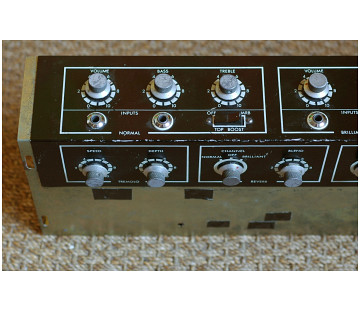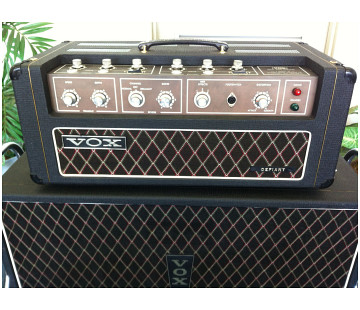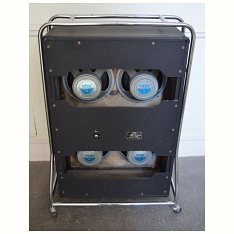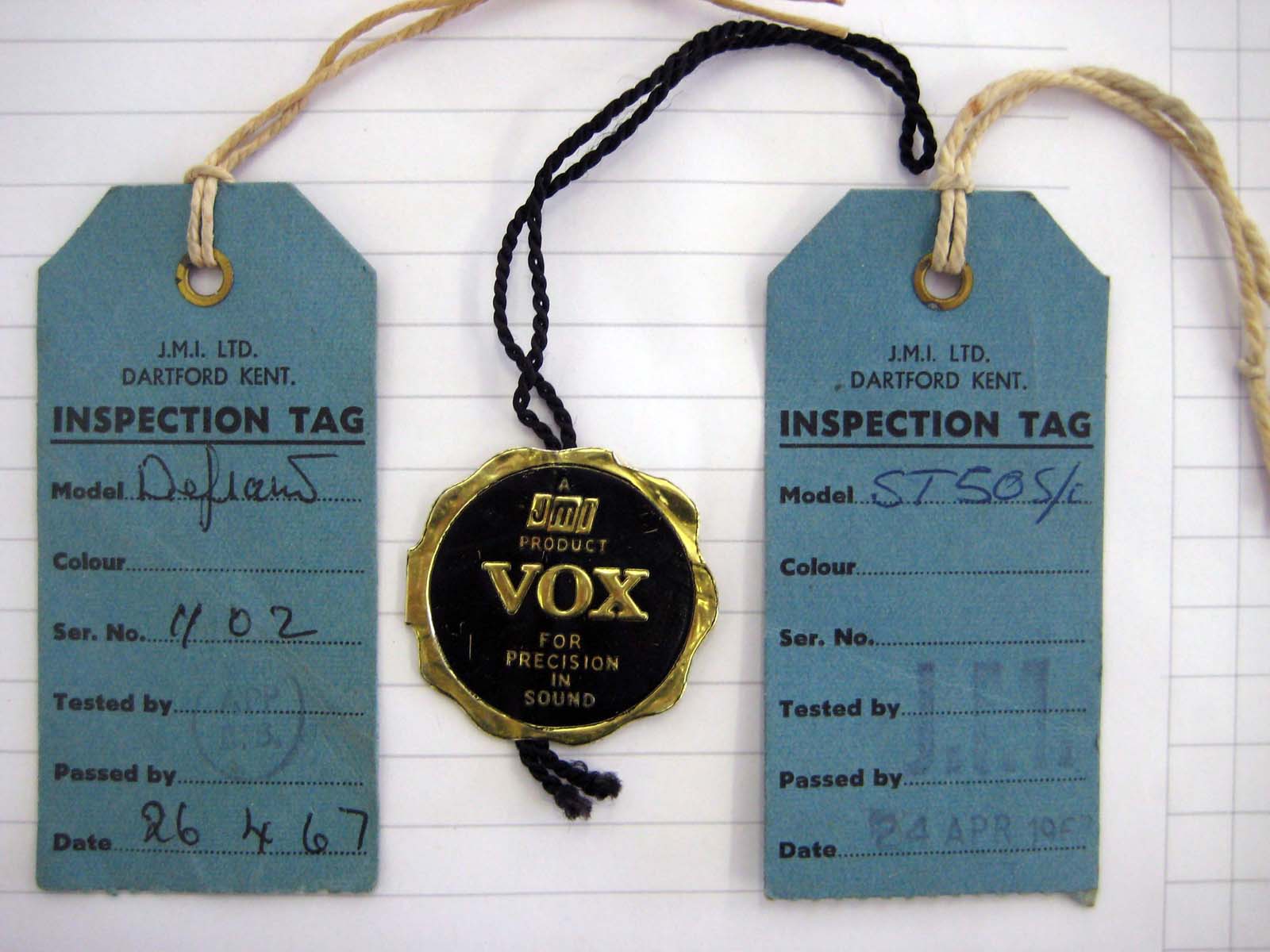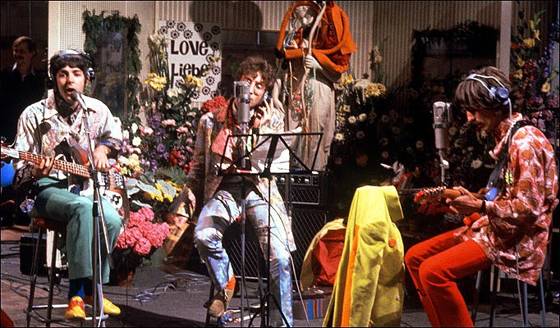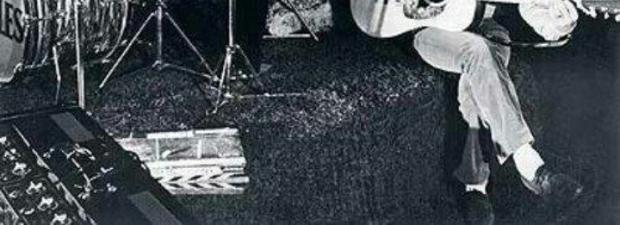GENERAL REMARKS ON:
Early Virtuosos, Conquerors, Defiants and Supremes
Above, two pages from the Vox solid state catalogue of July 1967.
Below a series of short sections on external elements that changed during the production of JMI solid state amps: principally, serial number plates and control panels. Further details along with numerous pictures can be found on the individual Traveller, Conqueror, Defiant and Supreme pages.
Also below, notes on "time-frame" markers, eg. The Rolling Stones photographed on stage on 27th March 1967 with standard production Supremes and a Super Foundation Bass.
For the date codes of components inside Vox solid state amps, now see this page.
1) Serial Numbers (general)
Sequences for the various models of amp began at 1000 or 1001 and ran through to different end points in the JMI period (1967).
After JMI folded in mid 1968, the company became "Vox Sound Equipment Ltd", and serial number sequences were restarted at 2000. "Vox Sound Ltd" continued where VSEL left off. Amps made in the "Vox Sound Ltd" period (1970-1973) are readily distinguishable by having one indicator lamp on the front rather than two; and silver string rather than gold around the cabs.
On VSEL, see the pages gathered together here. For VSL in the period 1970-1971, see these pages. Material on VSL, 1972-1973, can be found here.
Simply for reference: an early VSEL plate alongside a late VSL example: Supreme 2089 (hand-stamped), and Supreme 2574.
2) Serial Numbers and Model Names of the very earliest amps
The earliest amps are not designated "Conqueror" or "Defiant" on the serial number plate, but rather "ST30R" and "ST50R" = Super Twin 30 Reverb, and Super Twin 50 reverb, and so on. Super Twin indicated that amplifier section and speaker cabinet were separate units.
The serial number itself is given at first in plain form: ie. "1018". Cabs accompanying the amps are similarly named (ST30 and ST50).
Serial number plate of Defiant (ST50R) no. 1018.
The plate of the cab (ST50) accompanying Defiant (STR50) serial number 1031.
3) Serial Numbers and Model Names of the next earliest runs of amps
After the first forty or fifty amps had been produced, the decision was made to stamp the model name (eg. Conqueror, Defiant, Supreme), rather than the format of the amp, in the upper panel of the serial number plate.
Serial numbers now take the form ST--xxxx. Even the Supreme was regarded as being a "Super Twin" in spite of the fact that it really had more in common with the AC100 (never referred to as a "Super Twin") than with the other amps in the solid state range.
Supreme no. 1058
4) Later JMI amps (late 1967)
In certain runs of amps, the "ST" prefix was dropped. Towards the end of the JMI period, two line plates make an appearance, and one finds "AMPLIFIER" rather than "VOX AMPLIFIER" at the head of the plate.
Defiant 1535. Note the heading "AMPLIFIER". This remained the pattern through to JMI Defiant serial number 1587.
5) Control panels
a) Very early batches of control panels for the Virtuoso, Conqueror and Defiant seem predominantly to have been black and remained black, that is to say with no fading, or change of "colour".
On the left, Conqueror 1037; on the right, Defiant 1031
b) At some point soon after, a variant batch appears, but with a mistake: the legend for the Top Boost switch is not "OFF-ON", but "OFF-MRB". This has only been found so far on Conquerors, but it may turn up on Virtuosos and Defiants too.
On the left, Conqueror 1046; on the right, an early Conq. lacking its plate.
c) The third batch of panels, which came in at around Conqueror no. 1055 and Defiant no. 1100, either was, or has gone, brown.
On the left, Conqueror 1055; on the right, Defiant 1102.
d) The early Supremes that survive have brown panels. It is possible, however, that the very first had black.
A detail of the control panel of the heavily-used Supreme no. 1030.
The relative scarcity of early Supremes is interesting. Perhaps circumstantial reports that early batches of power transistors were unreliable are correct. Alternatively, it could be that JMI ran them far too hot. The power boards of early amps are often amazingly scorched.
6) Dates and Quantities
a) The Stones were already on stage with standard production Supremes and a Super Foundation Bass set-up on 27th March 1967.
Orebro, Sweden, 27th March 1967 with new Vox solid state equipment - image originally posted here by a fan who attended the concert.
Above, Mick Jagger standing behind Brian Jones's amp at Warsaw on 13th April 1967. The speakers in the cab are the same type as the ones centre and right - Celestion T1279s.
b) Defiant no. 1102 has hang-tags dated 24th and 26th April 1967; so evidently around one hundred units had already been produced by that date *in readiness for release*.
Defiant 1102: hang-tags for amp and cab.
7) Not "did the Beatles have Conquerors or Defiants?" They had Conquerors. But when did they get them?
The first photographic evidence of the Beatles with a Conqueror comes from 25th June, 1967: the "All You Need is Love" world broadcast.
The amp is also seen alongside a Vox UL430 in photos of the rehearsals on preceding days. There is nothing to indicate when this amp was consigned to The Beatles by JMI - it could, for all we know, have been months earlier.
For the recording of the promo video for "Hello Goodbye" at the Savoy Theatre on 10th November 1967, the band had two Conquerors (on top of Vox UL710 or Conqueror cabs with Celestion ceramic speakers). See Frank Carvalho's great page, here.
Savoy Theatre, 10th November, 1967. As ever, click the pic. for a larger version.
A detail of one of the amps at the Savoy Theatre during rehearsals. Note the two metal vents. Defiants had four. The larger version of the pic. will pop up when clicked.
One can also tell from the length of the runner lower right on the grille cloth that they are indeed Conquerors, not Defiants as is sometimes claimed.
A detail of John's amp. Note there is no "Solid State" in the logo.










